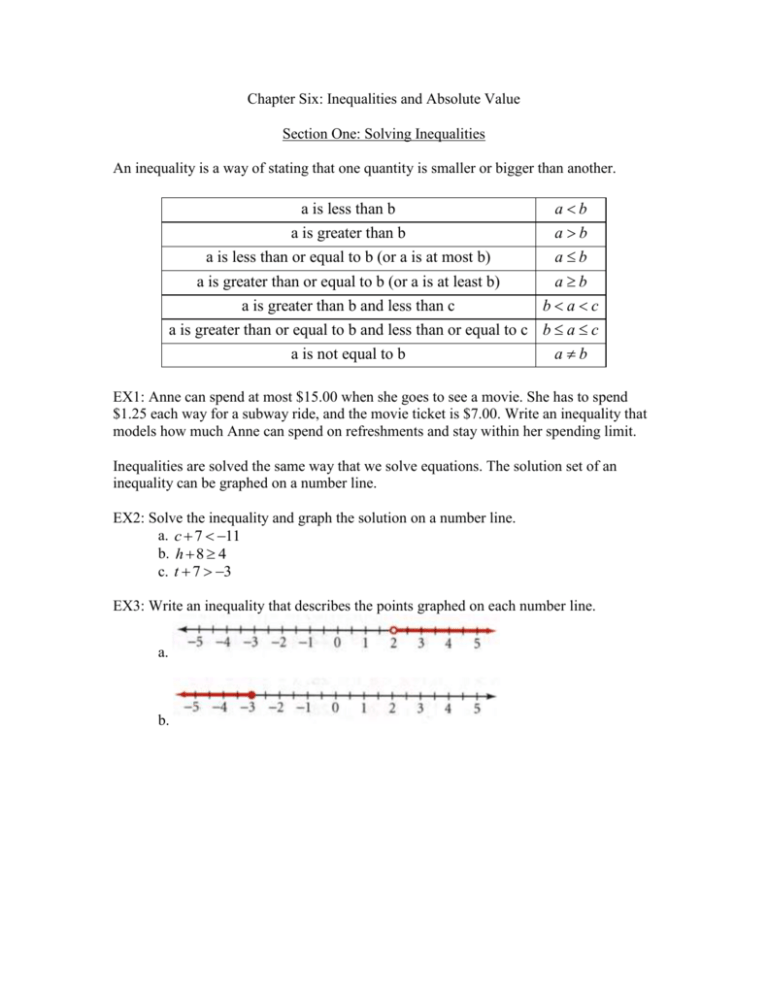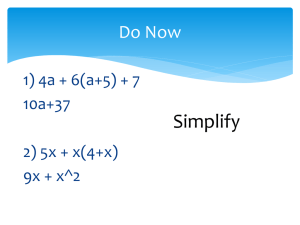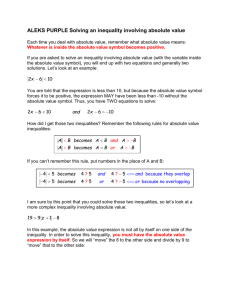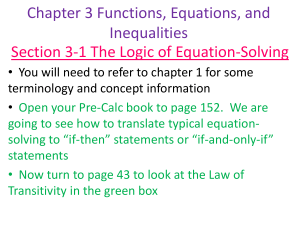Chapter Six: Inequalities and Absolute Value
advertisement

Chapter Six: Inequalities and Absolute Value Section One: Solving Inequalities An inequality is a way of stating that one quantity is smaller or bigger than another. a is less than b ab a is greater than b ab a is less than or equal to b (or a is at most b) ab a is greater than or equal to b (or a is at least b) ab a is greater than b and less than c bac a is greater than or equal to b and less than or equal to c b a c a is not equal to b ab EX1: Anne can spend at most $15.00 when she goes to see a movie. She has to spend $1.25 each way for a subway ride, and the movie ticket is $7.00. Write an inequality that models how much Anne can spend on refreshments and stay within her spending limit. Inequalities are solved the same way that we solve equations. The solution set of an inequality can be graphed on a number line. EX2: Solve the inequality and graph the solution on a number line. a. c 7 11 b. h 8 4 c. t 7 3 EX3: Write an inequality that describes the points graphed on each number line. a. b. Section Two: Multistep Inequalities Inequalities are solved the same way that equations are. There is only one exception. When multiplying or dividing both sides of an inequality by a negative, flip over the inequality symbol. EX1: Solve and graph each inequality. a. 4d 16 a b. 5 9 c. 56 8 y d. x 12 x e. 5 3 f. 4s 3 5s 17 g. 3x 2 x 4 3x 8 h. 2m 7 m 1 26 EX2: A company reimburses its sales personnel for work-related travel. The salesperson can choose one of two options. With option A, the salesperson receives a fixed amount of $150 per month. With option B, the salesperson receives $45 per month plus 35¢ per mile traveled. Under what conditions is option B more beneficial to the salesperson? Section Three: Compound Inequalities A compound inequality is when two inequalities are combined into one statement. We use the words “and” and “or.” Let’s discuss the difference between the two: Think about the statement, “Everyone that is a boy and 15 years old raise your hand.” Now consider the statement, “Everyone that is a boy or 15 years old raise your hand.” In an “and” sentence, both statements must be true. It is the intersection of the two statements. In an “or” sentence, either statement can be true. It is the union of two groups. EX1: Alan bought an aquarium and some fish at the pet store. He was told that his fish required water with at least 6 but no more than 10 parts per million of dissolved oxygen. Write and graph a compound inequality to describe the situation. EX2: On certain highways, it is illegal for a car to drive less than 45 or more than 65 miles per hour. Write and graph a compound inequality to describe the speeds that are prohibited. EX3: Graph the following inequalities. a. q 5 OR q 16 b. x 2 AND x 5 c. x 2 AND x 5 d. 3 x 7 (And statements can be written as a “sandwich”) EX4: Solve and graph the following compound inequalities. a. 2 5x 8 18 b. 6x 30 OR 4x 9 3 3w 1 2 c. 3w 2 3 AND 2 d. 2x 4 2 OR 2x 6 2 Section Four: Absolute-Value Functions The absolute value, as discussed before, is simply the positive of that number. EX1: Find each of the following absolute values. a. 7 9 b. 9 7 c. 7 7 The function y x is known as the absolute value function. The graph of this function is v-shaped as shown to the right. What is the domain and the range of the absolute value function? The function y x is an example of a parent function because it is the most basic absolute value function. The graph can be changed with different transformations. A translation is a transformation that simply moves or slides the original function. A reflection is a transformation that flips the original function across a line of reflection. A compression pushes the function in, while a stretch pulls the function out. EX2: Graph y x along with the given functions below. Find the domain and range of each function. Identify the type of transformation. a. y x 2 b. y x 3 c. y 3 x (This is two transformations) Section Five: Absolute-Value Equations and Inequalities One important application for absolute values is when factories deal with the amount of error in measurement. In this lesson we will solve equations and inequalities involving absolute value. To solve absolute value equations we will use the following steps: 1. Remove the absolute value bars and divide the equation into a positive equation and a negative equation 2. Solve each equation 3. Check the solutions! EX1: Solve each absolute value equation. a. x 3 b. 2 x 4 8 c. 2 z 21 33 d. 2 x 1 3 Absolute value inequalities can be solved using the following steps: 1. Solve the corresponding absolute value equation 2. Plot the points on a number line 3. Pick a number from each interval as a test number 4. The solution is the “working” intervals EX2: Solve each absolute value inequality a. x 7 3 b. x 5 2 c. x 4 5 d. x 3 2










